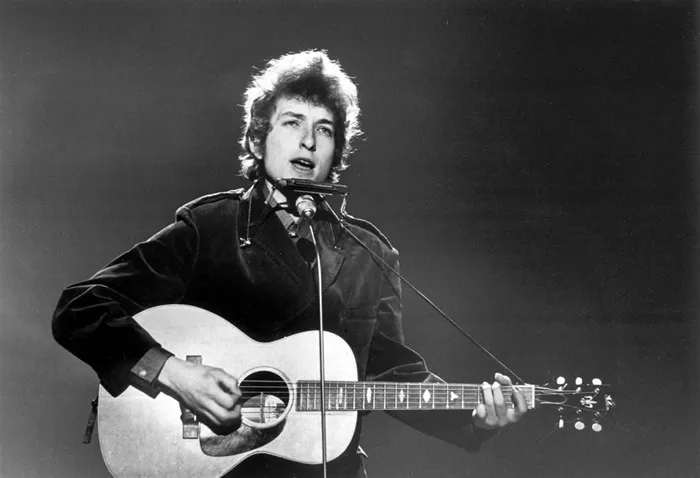Bob Dylan is one of the most influential figures in the history of rock music. His work spans decades and genres. Dylan’s unique style and innovative songwriting changed how music was created and perceived. He not only shaped rock but also left a mark on folk, country, and even pop music. In this article, we will explore Dylan’s profound influence on rock music through his lyrics, musical evolution, and cultural impact.
The Rise of Bob Dylan
Early Life and Influences
Bob Dylan was born Robert Zimmerman in 1941 in Duluth, Minnesota. He grew up listening to a wide variety of music. Influences included folk, blues, and rock and roll. These genres would play a crucial role in his development as an artist. Dylan moved to New York City in the early 1960s. He immersed himself in the vibrant folk scene. This environment allowed him to meet other influential musicians. They would help shape his sound and vision.
The Release of “The Freewheelin’ Bob Dylan”
In 1963, Dylan released “The Freewheelin’ Bob Dylan.” This album marked a turning point in his career. It included iconic songs like “Blowin’ in the Wind” and “A Hard Rain’s A-Gonna Fall.” These songs featured complex lyrics and social commentary. They addressed issues such as war and civil rights. This was a departure from the simpler love songs typical of the era. Dylan’s lyrics became a model for future rock songwriters.
The Evolution of Rock Music
The Shift in Songwriting
Dylan’s approach to songwriting changed the landscape of rock music. Before him, many rock songs were simple and focused on catchy melodies. Dylan introduced deeper themes and narratives. His use of vivid imagery and poetic language set a new standard. Other artists began to emulate his style. They started writing songs that tackled social and political issues. This shift gave rock music more depth and significance.
The Influence on Other Artists
Many artists cite Dylan as a major influence. The Beatles, for example, were inspired by his work. They shifted their songwriting style after hearing Dylan’s music. Songs like “Norwegian Wood” reflect this influence. Dylan’s focus on introspective lyrics encouraged bands to explore new themes. Artists such as Neil Young and Bruce Springsteen also followed in his footsteps. They incorporated storytelling and personal experience into their songs.
The Transition to Electric Music
The Infamous Newport Folk Festival
In 1965, Dylan made a controversial decision. He went electric at the Newport Folk Festival. This moment shocked fans and critics alike. Dylan’s performance with a full rock band signaled a new direction for his music. It blended folk and rock elements in a way that had not been done before. This transition opened doors for other folk artists to experiment with electric instrumentation. It changed the sound of rock music forever.
The Release of “Highway 61 Revisited”
Following his electric debut, Dylan released “Highway 61 Revisited.” This album featured the groundbreaking track “Like a Rolling Stone.” The song was unlike anything that had come before it. It mixed rock, blues, and poetry into a single piece. The song’s structure and lyrical content expanded the possibilities of rock music. It became a blueprint for future rock and pop songs.
The Cultural Impact of Bob Dylan
The Voice of a Generation
Dylan became the voice of the 1960s counterculture. His music resonated with the youth of the time. His songs spoke to their desires for change and freedom. They expressed the frustrations and hopes of a generation. This connection solidified his status as an icon. Dylan’s music was not just entertainment; it was a form of activism. Songs like “The Times They Are A-Changin'” became anthems for social movements.
Impact on Political Music
Dylan’s influence extended beyond rock. He inspired a wave of politically charged music. Artists began to use their platforms to comment on societal issues. This trend continued into the 1970s and beyond. Musicians like Joan Baez and Phil Ochs drew inspiration from Dylan’s style. They tackled topics such as civil rights, war, and environmental issues. Dylan helped to legitimize political discourse in music.
The Legacy of Bob Dylan
Continued Relevance
Bob Dylan’s impact on rock music is undeniable. His ability to evolve and adapt has kept his music relevant. Even in the 21st century, his songs continue to inspire new generations. Artists from various genres cite him as a key influence. This includes rock, pop, hip-hop, and beyond. His legacy is felt in the work of contemporary musicians. They still draw from his lyrical and musical innovations.
Awards and Recognition
Dylan has received numerous awards throughout his career. In 2016, he was awarded the Nobel Prize in Literature. This recognition solidified his status as a literary figure. It highlighted the importance of his songwriting in the broader context of literature and art. Dylan’s work transcends music. It has become an essential part of cultural history.
See Also: Which Style of Music Did Carl Perkins Combine with Rock?
Conclusion
Bob Dylan’s influence on rock music is profound and lasting. He transformed songwriting with his deep, poetic lyrics. His shift to electric music changed the genre’s sound and direction. Dylan’s songs became anthems for social change, connecting with the youth of his time. His legacy continues to inspire artists today. The impact of his work is felt across generations. Bob Dylan will always be remembered as a pioneer who reshaped the landscape of music. His contributions are invaluable, and his influence will endure for years to come.
Related Topics
Exploring the Influence of Jazz on Rock ‘n’ Roll

